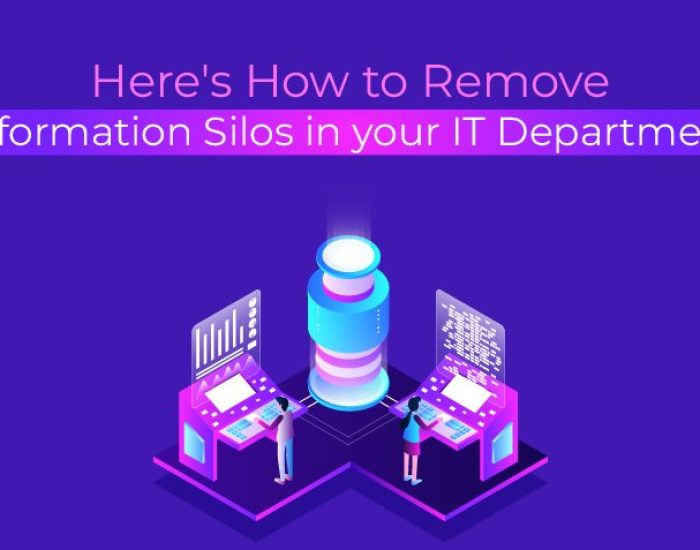Removing The Information Silos in your IT Department
Information silos can be destructive Without collaboration, when performance problems occur (and they often do) everyone blames each other, resulting in a lack of focus, delays in problem resolutions and reputation damage. Facilitating collaboration between groups that don’t typically work together (developers, programmers, and infrastructure managers) will lead to better productivity, better code and in the long run a better company and application reputation.
To accomplish this will require exercises that emphasize mutual understanding, trust-building, and open communication. Here’s a recommended exercise that will help you:
Cross-Training Workshop
These work well to foster mutual understanding, appreciation, and collaboration between two different groups by having them teach each other about their roles, challenges, and responsibilities.
A 5 Step Process:
1. Introduction:
- Begin with an icebreaker activity that gets everyone relaxed and talking. This could be something as simple as “Two Truths and a Lie” or “Speed Networking.”
- Introduce the objective of the workshop: “Today, we’re here to understand each other’s roles, challenges, and perspectives better.”
2. Role Reversal Presentations:
- Divide members from each group into pairs or small teams, mixing the two groups.
- Assign each team a topic or task that’s typically handled by one group. The twist: Teams must prepare a brief presentation or demonstration on that topic, but they can’t include members from the group that typically handles that task.
- Give teams time to research, discuss, and prepare. Members of the group that typically handles the task can act as “consultants” or “experts” but should not dominate the preparation.
- After preparation, each team presents or demonstrates their topic to the larger group.
3. Discussion & Reflection:
- After all presentations, open the floor for discussion. What did participants learn? Were there any surprises or misconceptions?
- Discuss the challenges each group faces and brainstorm ways the other group could potentially support or collaborate with them in the future.”
4. Collaborative Problem Solving:
- Present a hypothetical (or real) challenge that requires input and expertise from both groups to solve.
- Have mixed teams work together to come up with a solution, emphasizing the importance of each group’s contribution.
- Have each group share their solution, and then discuss the merits of each approach, highlighting collaborative moments.
5. Feedback & Future Collaboration:
- Conclude by asking participants to share feedback on the exercise and discuss any insights or takeaways.
- Encourage both groups to discuss potential collaboration points in the future, using the insights gained from this workshop.
 What this accomplishes
What this accomplishes
The more programmers or developers can understand Infrastructure and vice versa the better the application environment will be, resulting in;
- Efficient Resource Utilization: Infrastructure managers have a deep understanding of available resources, such as computing power, storage, and network capabilities. By communicating with developers, they can ensure that applications are optimized for the available resources, preventing over or under-utilization, which can either lead to wasted resources or underperforming applications.
- Scalability and Performance: Developers design applications with certain performance expectations. By being in sync with infrastructure managers, they can ensure that the infrastructure can support the application’s scalability and performance requirements, especially during peak usage times.
- Security Considerations: Infrastructure managers are typically aware of the security constraints and policies of the environment. Developers need this information to ensure that their applications are compliant with security protocols. Together, they can ensure a robust security posture, minimizing vulnerabilities.
- Cost Optimization: Without coordination, there’s a risk of over-provisioning or misallocating resources, leading to unnecessary costs. Proper communication can ensure cost-effective resource allocation, balancing performance and financial considerations.
- Faster Problem Resolution: When issues arise, having a good relationship and open communication channels between developers and infrastructure managers can lead to quicker problem diagnosis and resolution. This is especially crucial in production environments where downtimes can have significant business impacts.
- Improved Deployment Cycles: Continuous integration and continuous deployment (CI/CD) practices require tight coordination between development and infrastructure. When both teams are in sync, it results in smoother, faster, and more frequent deployments, which benefits the business by delivering features and fixes more rapidly.
- Infrastructure Evolution: As technology evolves, infrastructure needs to be updated or replaced. Developers need to be in the loop about these changes to ensure that applications remain compatible and can leverage new features or improved performance.
- Risk Mitigation: Unexpected changes or lack of coordination can lead to failures. For example, an infrastructure manager might implement a change unaware that it breaks a critical application. Proper communication helps in assessing and mitigating such risks.
- Knowledge Sharing: Both developers and infrastructure managers bring unique perspectives and knowledge to the table. Regular interactions can lead to cross-pollination of ideas, leading to innovative solutions and better overall system design.
- Alignment with Business Goals: Ultimately, both teams work towards achieving the organization’s objectives. By communicating and collaborating, they ensure that technical efforts align closely with business goals, creating value and ensuring that both application development and infrastructure provisioning work in harmony to meet organizational targets.
For modern, agile, and efficient IT operations, synchronization between developers and infrastructure managers is not just a good practice; it’s a necessity. Protected Harbor practices this every day and is part of our culture. If you would like to discuss this or chat about how we do it, give me a call. Rich Luna






